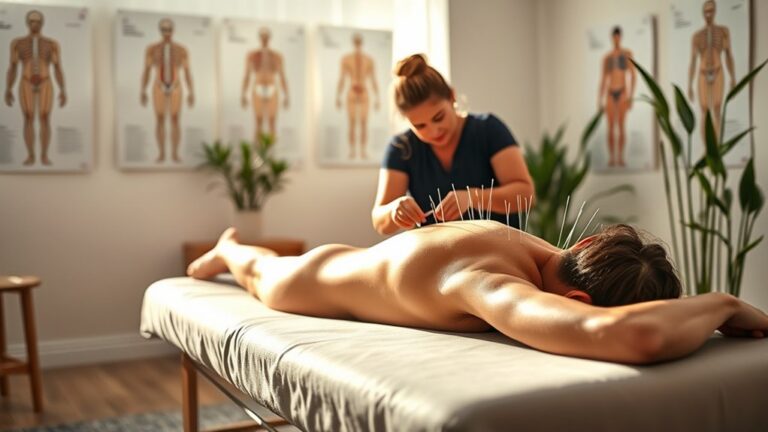The Best Active Recovery Workouts for Gym Athletes
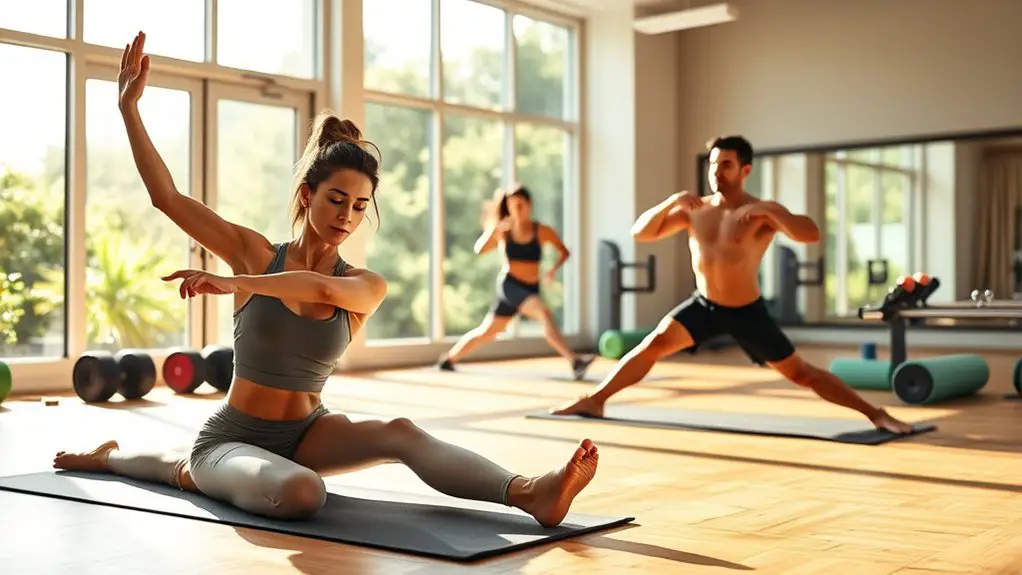
Active recovery is essential for gym athletes aiming to boost performance and avoid injuries. Incorporate practices like yoga for flexibility, foam rolling to relieve muscle tightness, and low-intensity cardio such as walking or cycling to enhance blood circulation. Swimming offers a full-body workout without impact, while Pilates strengthens your core and stability. Don’t overlook mobility drills to improve joint function and mindfulness practices for mental clarity. Discover how each of these can elevate your recovery game.
Importance of Active Recovery for Athletes
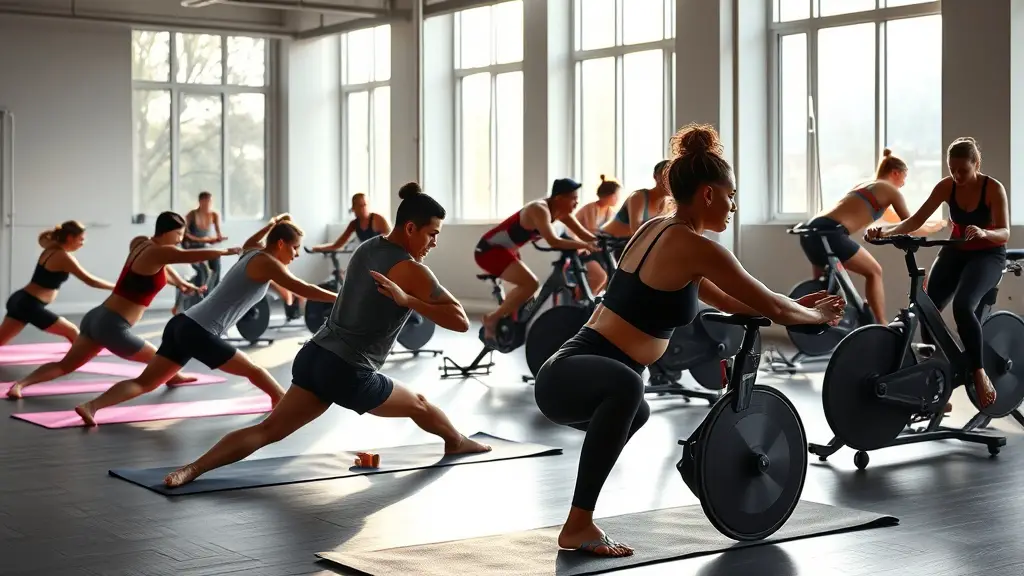
While you might think that resting means doing nothing, active recovery is essential for athletes looking to enhance performance and reduce injury risk. Incorporating effective recovery techniques, like light jogging, cycling, or swimming, allows your body to actively flush out toxins and improve blood circulation. This promotes muscle regeneration, helping your muscles repair and rebuild after intense workouts.
Active recovery keeps your body moving without straining it, striking the perfect balance between rest and activity. It can also help alleviate soreness and stiffness, making it easier to return to training stronger. Plus, engaging in low-impact exercises can boost your mental focus, keeping you motivated and ready for your next session.
Yoga: Enhancing Flexibility and Relaxation
Incorporating yoga into your active recovery routine can greatly enhance your flexibility and promote relaxation. By focusing on specific yoga poses and breathing techniques, you’ll not only recover faster but also improve your overall performance. Here are four benefits of adding yoga to your regimen:
- Increased Flexibility: Regular practice of yoga poses like Downward Dog and Pigeon can help lengthen tight muscles.
- Stress Relief: Breathing techniques such as pranayama lower cortisol levels, helping you unwind after intense workouts.
- Improved Circulation: The combination of movement and breath promotes better blood flow, aiding muscle recovery.
- Mind-Body Connection: Yoga encourages mindfulness, allowing you to listen to your body and adjust your training accordingly. Additionally, incorporating activities like jump rope can further enhance your overall fitness routine by engaging your core and improving cardio.
Make yoga a staple in your active recovery routine, and watch as both your flexibility and relaxation levels soar!
Foam Rolling: Myofascial Release Techniques
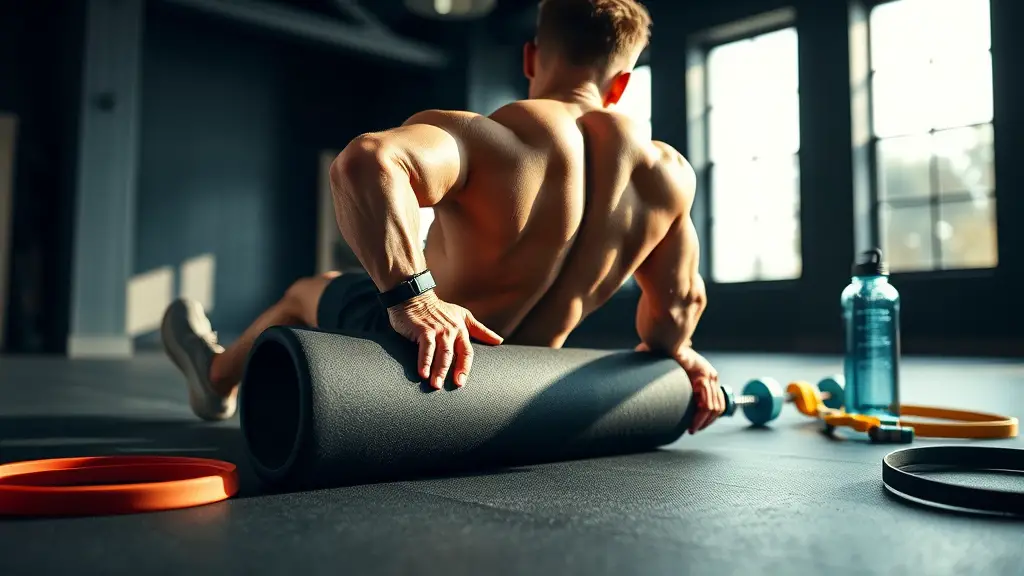
Foam rolling is a powerful tool for athletes looking to enhance their active recovery. By incorporating myofascial release techniques into your routine, you can alleviate muscle tightness and improve overall performance. The foam rolling benefits extend beyond just relaxation; it helps increase blood flow, reduce soreness, and improve flexibility.
When you roll over tight areas, you’re breaking up adhesions and knots within the fascia, the connective tissue surrounding your muscles. This not only promotes recovery but also prepares your body for future workouts.
To get started, focus on major muscle groups like your quads, hamstrings, and back. Spend 30-60 seconds on each area, applying pressure and rolling slowly. You’ll quickly notice how effective this simple technique can be in elevating your recovery game. So, grab that foam roller, and make myofascial release a staple in your active recovery strategy!
Low-Intensity Cardio: Keeping the Blood Flowing
Engaging in low-intensity cardio can be a game-changer for your active recovery routine, as it keeps the blood flowing and aids in muscle repair. This type of workout helps maintain a moderate heart rate, which is essential for recovery without overexerting yourself. Here are four effective low-intensity cardio options you can integrate into your routine:
- Walking: Aim for 30-60 minutes at a brisk pace to keep your heart rate elevated but manageable.
- Cycling: Use a stationary bike for about 45 minutes, adjusting resistance for comfort.
- Elliptical Training: Spend 30-45 minutes at a steady pace, engaging your upper and lower body.
- Light Jogging: Keep it easy for 20-40 minutes to promote circulation without excessive strain.
Swimming: A Full-Body, Low-Impact Workout

Swimming offers an excellent way to enhance your active recovery routine, providing a full-body workout that’s easy on the joints. Unlike high-impact exercises, swimming allows you to engage in movements that promote flexibility and strength without the risk of injury. By utilizing various swimming techniques, such as freestyle or breaststroke, you can target different muscle groups while benefiting from the calming properties of water.
The water resistance you experience during swimming creates a natural form of resistance training, helping to build endurance and muscle tone. As you glide through the water, your body works hard to maintain balance and coordination, which further enhances your core stability.
Incorporating swimming into your recovery days not only keeps your heart rate up but also aids in muscle recovery through gentle movement. So, jump in and make swimming a staple in your active recovery routine—you won’t regret it!
Stretching Routines: Improving Mobility and Preventing Injury
Incorporating a solid stretching routine into your active recovery days can greatly improve your mobility and reduce the risk of injury. By focusing on both dynamic and static stretching, you can enhance your flexibility and prepare your body for intense workouts. Here’s a simple routine to follow:
- Dynamic Stretching: Start with leg swings and arm circles to warm up your muscles.
- Hip Flexor Stretch: Kneel on one knee and push your hips forward, holding for 20-30 seconds.
- Hamstring Stretch: Sit on the floor, extend one leg, and reach for your toes; switch legs after 20-30 seconds.
- Shoulder Stretch: Pull one arm across your body, holding it with the opposite arm for added tension.
Walking: Simple Yet Effective Recovery
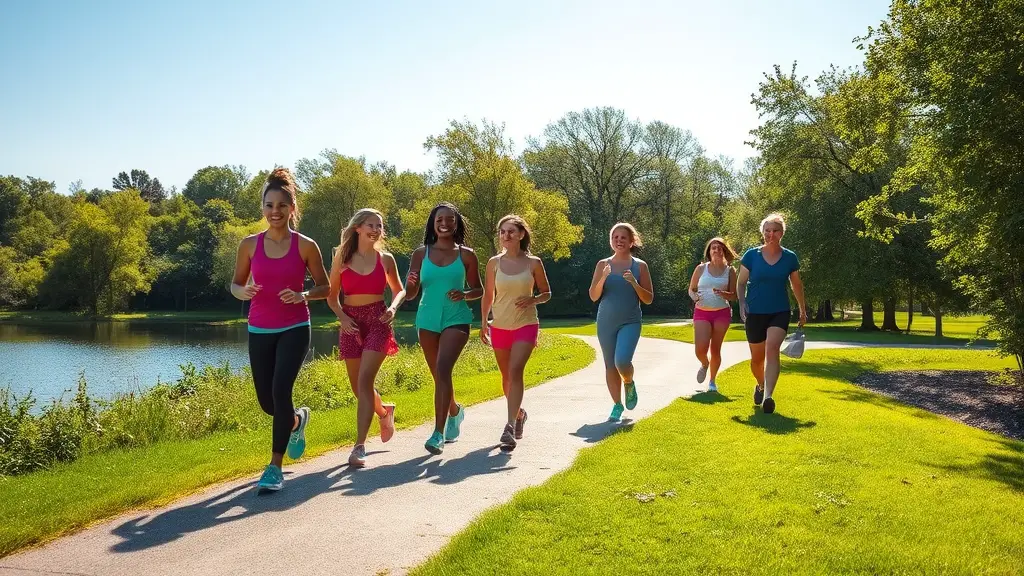
After a solid stretching routine, walking can be a fantastic way to enhance your active recovery. It’s simple yet effective, offering numerous walking benefits that can help you bounce back after intense workouts. Walking promotes blood circulation, which aids in muscle recovery and reduces soreness.
To maximize these benefits, focus on proper walking techniques. Maintain an upright posture, engage your core, and take steady, deliberate steps. Incorporating intervals of brisk walking can elevate your heart rate, providing an extra boost to your recovery process.
Aim for at least 20-30 minutes of walking, whether on a treadmill or outdoors. Not only does it clear your mind, but it also encourages relaxation, making it a perfect complement to your overall training regimen. By integrating walking into your routine, you’ll enhance your recovery, setting you up for greater success in your next workout session.
Pilates: Core Strength and Stability
If you want to boost your athletic performance, focusing on core strength and stability through Pilates can make a significant difference. This practice not only enhances your balance but also provides a solid foundation for all your movements, reducing the risk of injury. By incorporating Pilates into your routine, you’re setting yourself up for greater success in the gym and beyond.
Benefits of Core Strength
Core strength is the foundation of athletic performance, providing stability and balance that every gym athlete needs. When you focus on improving your core strength, you’ll notice several benefits that enhance your workouts:
- Improved Core Stability: A strong core helps you maintain proper posture and alignment during exercises, reducing the risk of injury.
- Enhanced Core Endurance: Increased endurance allows you to perform longer and more intense workouts without fatigue.
- Better Balance: A stable core contributes to better balance, essential for various athletic movements and activities.
- Increased Power: Strengthening your core translates into more powerful movements, whether you’re lifting weights or sprinting.
Investing time in core workouts, like Pilates, can greatly elevate your athletic performance.
Enhancing Stability Through Pilates
A strong core is just the beginning of achieving ideal stability in your workouts. By integrating Pilates foundations into your routine, you’ll not only enhance core strength but also improve overall balance and control. Stability exercises in Pilates focus on maintaining proper alignment, which can greatly benefit your athletic performance.
Here’s a quick overview of key Pilates stability exercises:
| Exercise | Benefits |
|---|---|
| Plank | Strengthens core and shoulders |
| Bridge | Activates glutes and hamstrings |
| Single-leg Stretch | Improves hip stability |
| Side Plank | Enhances lateral stability |
| Teaser | Boosts overall core strength |
Incorporating these exercises will help you achieve the stability necessary for peak performance and injury prevention.
Mobility Drills: Enhancing Joint Function
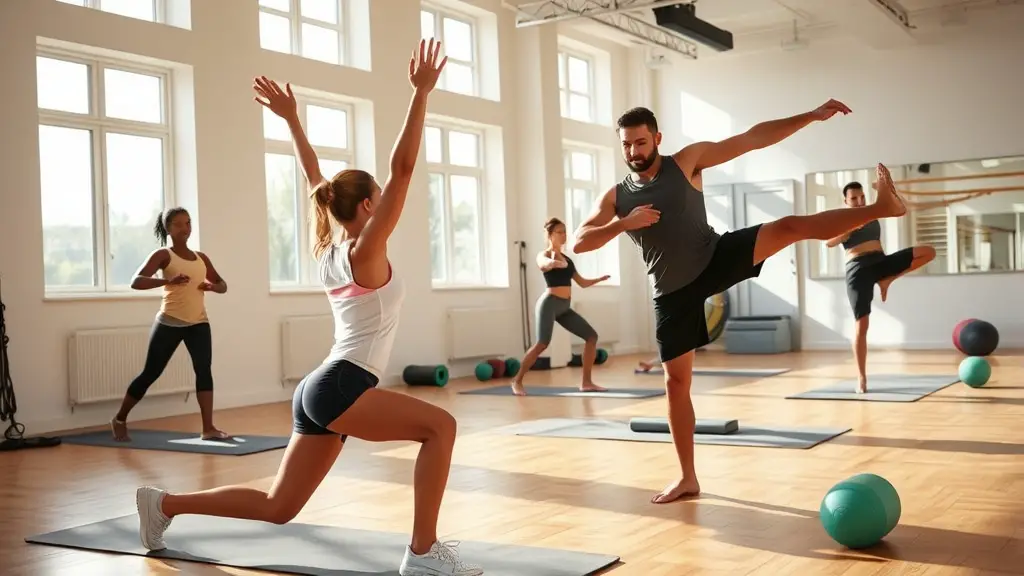
While you may focus on strength and endurance in your workouts, neglecting mobility can hinder your overall performance and increase injury risk. Enhancing joint mobility is essential for achieving functional movement, and incorporating mobility drills into your routine can make a significant difference. Here are four effective drills to take into account:
- Hip Circles: Stand on one leg and rotate your other leg in circular motions to loosen up your hip joint.
- Ankle Rolls: Lift one foot and roll your ankle in both directions to improve flexibility and prevent stiffness.
- Spinal Twists: Sit cross-legged and gently twist your torso to each side, enhancing spinal mobility.
- Shoulder Dislocates: Use a resistance band to perform this drill, promoting shoulder joint flexibility.
Mindfulness and Meditation: Recovery for the Mind
In the pursuit of peak performance, it’s easy to overlook the mental aspect of recovery, yet incorporating mindfulness and meditation can be transformative. By practicing mindful breathing, you can calm your mind and reduce stress, allowing your body to recover more effectively. Just a few minutes a day of focused breathwork can enhance your mental clarity, sharpening your focus for future workouts.
Engaging in meditation not only promotes relaxation but also fosters resilience, helping you to bounce back from physical and mental fatigue. Imagine taking a moment post-workout to center yourself, letting go of distractions, and refocusing your energy. This practice can enhance your overall performance, ensuring you’re not just physically fit but mentally sharp as well.
Frequently Asked Questions
How Often Should I Incorporate Active Recovery Workouts Into My Routine?
You should aim to incorporate active recovery workouts into your routine at least once or twice a week. Following frequency guidelines helps guarantee you’re giving your body the recovery it needs without overdoing it. These sessions can greatly enhance recovery benefits, reducing muscle soreness and improving flexibility. By prioritizing active recovery, you’ll maintain your overall performance and prevent burnout, keeping your workouts effective and enjoyable in the long run.
Can Active Recovery Workouts Replace Traditional Rest Days?
While some might think active recovery workouts can replace traditional rest days, that’s not entirely true. Active recovery benefits, like improved blood flow and reduced soreness, are great, but your body still needs complete rest to repair and grow stronger. Consider recovery day alternatives, like gentle yoga or walking, instead of working out hard every day. Balance is key; incorporate both active recovery and proper rest to optimize your performance and well-being.
What Are the Signs I Need More Active Recovery?
If you’re wondering about signs that you need more active recovery, look for fatigue indicators like persistent tiredness, decreased performance, or irritability. Muscle soreness that lingers beyond a few days can also signal your body’s need for lighter activity. It’s essential to listen to these signals; incorporating active recovery can help rejuvenate your muscles and improve overall performance. Don’t ignore your body—it knows what it needs to recover and thrive!
Are There Specific Active Recovery Workouts for Different Sports?
Absolutely, there are sport-specific activities that can enhance your recovery. For instance, if you’re a runner, light jogging or dynamic stretching can help. Swimmers might benefit from gentle water aerobics, while cyclists could use easy rides or foam rolling. Integrating these recovery techniques not only helps prevent injuries but also improves performance. Tailoring your active recovery to your sport guarantees you’re staying engaged while promoting healing and readiness for your next session.
How Long Should Each Active Recovery Session Last?
Imagine your body as a finely tuned engine, needing just the right fuel to keep running smoothly. For active recovery, duration guidelines suggest keeping each session between 20 to 60 minutes, depending on your session intensity. If you’re cruising at a light pace, stick to the lower end; but if you’re pushing a bit harder, aim for the upper limit. This balance helps maintain performance while ensuring your body rejuvenates effectively for the next challenge.

